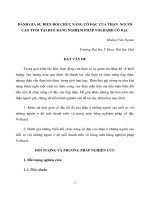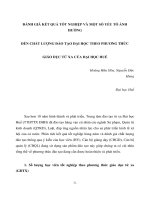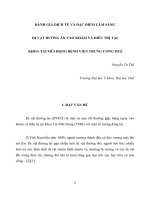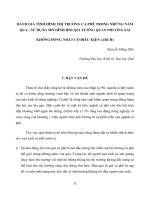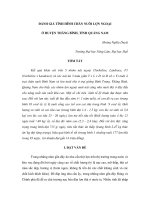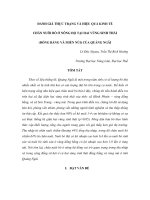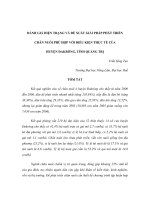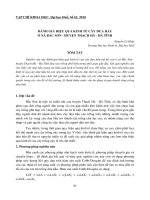Báo cáo nghiên cứu khoa học: "Đánh giá kết quả giáo dục sức khỏe về rối loạn lipid máu, bằng cách sử dụng một mạng lưới các nhân viên y tế cộng đồng tại thành phố Huế" pot
Bạn đang xem bản rút gọn của tài liệu. Xem và tải ngay bản đầy đủ của tài liệu tại đây (323.53 KB, 13 trang )
JOURNAL OF SCIENCE, Hue University, N0 61, 2010
ASSESSMENT OF HEALTH EDUCATION OUTCOMES ABOUT
DYSLIPIDEMIA, USING A NETWORK OF COMMUNITY HEALTH
WORKERS IN HUE CITY
Doan Phuoc Thuoc
College of Medicine and Pharmacy, Hue University
Nguyen Thi Kim Tien
Vietnam's Ministry of Health
SUMMARY
Dyslipidemia is very common in the community and is an important risk factor of
atherosclerosis and coronary artery disease with high mortality. A community intervention of
health education is designed to progressively reduce dietary intake of satuprevalenced fats,
cholesterol, total calories and increase physical activities to decrease dyslipidemia. The
intervention was conducted by a network of medical staffs in wards and intergprevalence with
other health programmes. After 12 months of intervention, the prevalence of dyslipidemia
decreased 11.6% (from 39.3% to 27.7%). The prevalence of high serum total cholesterol (TC)
levels reduced from 20.4% to 11.1%, LDL-C levels reduced from 15.7% to 6%, triglicerides
levels did not change. Average values of serum HDL-C levels increased (from 53.6 mg / dL to
63.9 mg / dL) and LDL-C levels reduced (from 119.4 mg / dL to 100.6 mg / dL) (p <0.05);
average values of TC and TG did not change. Dietary and physical activity habits reduced
intake of satuprevalenced fats and alcohol, higher intake of vegetables, and fish. Higher
prevalence of exercise and sports. Excessive intake of alcohol per day reduced from 37.1% to
6.6%. Knowledge of dyslipidemia, dietary and physical activity also improved. There was an
increase in the prevalence of people who came clinic to test blood lipid by themselves (from
0.9% to 20.2%) and know results of the test (from 3.2% to 28.8%); an increase in prevalence of
treatment dyslipidemia (from 2.3% to 16%); among of them, the application of lifestyle changes
in treatment increased from 0.4% to 13.7% (p<0.05). Community health education on
dyslipidemia based on a network of medical staff in wards improved the level of knowledge and
behavior change surrounding the prevention and treatment of dyslipidemia, and effectively
reduced the dyslipidemia prevalence in the community.
1. Introduction
Dyslipidemia is very common in the community, and is called a “New World
Syndrome” by World Health Organization . Dyslipidemia is an important risk factor of
atherosclerosis and coronary artery disease with high mortality . Many studies show that
467
secondary causes (lifestyle habits) play an important role in the process of dyslipidemia,
including high fat diet, sedentary lifestyle, few physical activities, drinking too much
alcohol (lifestyle factors) and poor knowledge of dyslipidemia. The fact that changing
lifestyle habits will reduce prevalence of dyslipidemia and coronary disease risk has
been identified in developed countries.
In Vietnam in general and Hue city particularly, the education program related to
dyslipidemia is very limited, so detection, prevention and treatment of dyslipidemia
does not receive adequate concern.
Doctors in hospitals often use drugs to treat those individuals with dyslipidemia.
It's important in health care strategy to reduce the morbidity in community and increase
the prevalence of detection and treatment to have long term effects. The study
"Assessment of health educational outcomes about dyslipidemia using a network of
community health workers in Hue City" was conducted to assess the behavioral
changes in prevention and treatment of dyslipidemia and evaluate the prevalence of
dyslipidemia decreasing in people aged 20 years or older in Hue city through
community health education.
2. Methodology
- The subjects of the study were adults aged 20 years or older in Hue city
- Study design: A community intervention of health education is designed to
progressively reduce dietary intake of saturated fats, cholesterol, total calories and
increase physical activities to decrease dyslipidemia; the intervention was conducted for
12 months from 3/2008 to 5/2009 by a network of medical staffs in wards and intergrate
with other health programmes.
- Sample size: 350 adults aged 20 and older, calculated by following
formula
n
2 p (1 p ) F
d 2
▪ F = 7,9; d: difference between dyslipidemia prevalence before (pA) and after
(pB) health education; pA : 35.08 % and pB : 25 % (expectantly)
- Sample: Choose two wards of Hue city randomly, randomly select five groups
(administrative units of ward) per ward, and 35 people aged 20 years and older per
group selected according to a list
- Methods of data collection:
+ A community survey to collect data before the community health education on
dyslipidemia
468
+ Implement health education programs based on a network of community
health workers for 12 months
+ A community survey to collect data after 12 months of lipid education
- The information collected
+ Personal information: age, gender, occupation
+ Eating habits, physical activity, drinking beer / wine
+ Knowledge about blood lipid and dyslipidemia
+ Test blood lipid, prevention and treatment of dyslipidemia
+ The prevalence of dyslipidemia, blood level of lipid components
- Methods of research evaluation:
+ Comparison of previous and after index and prevalence of the application
program for community health education on blood lipids and evaluate the difference
between prevalences based on the P value < 0.05 and intervention effective (IE)
IE
p 1
p 2
P 1
100
P1: exposure prevalence in control group, P2: The prevalence of exposure in the
education group
- Health education on lipids
Community communication and health education:
+ Public communication 6 times/ 12 months;
+ Play media, talk, leaflets at the meeting in wards and groups
Consultation and communication at families: From March 2008 to 3 in 2009
+ Medical staff of the ward to households integrated with implementation of
other health programs to interview, discusion, guidance, encouragement, leaflets and
video tapes for households.
Communication in ward health centers, pharmacies, and private clinics
- The concept of research variables
+ Blood lipid disorders classification:
469
Table 2.1. Blood lipid disorders classification: according to NCEP ATPIII 2002
LDL-C (mg/dL)
<100
Optimal
100-129
130-159
Desirable
Borderline high
High
<40
Low
60
High
<150
Desirable
150-199
Borderline high
200-499
High
500
(mg/dL)
<200
240
TG
Very high
200-239
HDL-C (mg/dL)
High
190
(mg/dL)
Borderline high
160-189
CT
Near Optimal
Very high
Source: Third Report of the National Cholesterol Education Program, 2002
+ Physical activity level
Sedentary: Typical daily living activities ( below 30 minutes per day)
Low active: Sedentary plus 30 to 60 minutes of moderatedaily activity
(e.g. brisk walking)
Active: Low active plus at least 60 minutes of moderate daily activity
(e.g. brisk walking)
Very active: Active plus an additional 60 minutes of vigorous activity
(e.g. jogging, biking) or 120 minutes of moderate activity (e.g. brisk
walking)
+ Eating habit
Habit of eating much vegetables, fat, sweet is like eating much
vegetables or fat, or sweeteners and food continuously doesn’t make
sense (4-7 days / week).
470
+ The habit of drinking too much alcohol /beer/ wine:
Drinking more than one cup (women) and two cups (male) of alcohol of all
kinds per day, a cup being equivalent to 50ml of strong wine, equivalent to 150 ml of
wine and 1 can of beer.
+ Knowledge of dyslipidemia: Evaluation of the three groups of knowledge:
good knowledge, average, and bad, based on the following score scale
Bad level: The total score of each answer (S) in each group is lower than the
average of the sample (S
Good level: S > M+SD
- Analysis and data processing: Using the SPSS 10.0 program and Epi info 6.04
3. Results
3.1. Results of behavioral change of prevention and treatment
- Change of lifestyle habits on the sample before-after health education
Table 3.1. The prevalence of lifestyle habits on the sample before-after health education
Before health education
(n= 350)
After health
education
(n= 350)
%
%
High fat diet
35.6
16.6
<0.05
Much vegetables, fish
43.5
69.7
<0.05
Sweet and starch
9.7
7.4
>0.05
Undefined
11.1
6.3
<0.05
No exercise
58.8
19.1
<0.05
Walk
33.3
71.1
<0.05
Badminton
6.9
5.4
>0.05
Running
0.5
2.8
<0.05
Others
0.5
1.5
<0.05
Lifestyle habits
P
(Chisquare)
Eating
Physical activity
471
Level of physical
activity/day
Sedentary
26.9
2.9
<0.05
Low active
14.4
25.7
<0.05
Active
14.8
26.9
<0.05
Very active
44.0
44.6
>0.05
Too much
37.1
6.6
<0.05
Moderate
31.9
18.9
<0.05
No drinking
31.0
74.6
<0.05
Drinking alchohol
After health education on blood lipids, the prevalence of participants eating high
fat decreased from 35.6% to 16.6%; eating many vegetables, and fish increased from
43.5% to 69.7%. The prevalence of people who exercise and play sports increased.
Brisk walking is common, the prevalence increased from 33.3% to 71.1%. The
prevalence of people who were sedentary reduced from 26.9% to 2.9%, much drinking
alcohol decreased from 37.1% to 6.6%,
3.2. Compare knowledge levels of dyslipidemia before - after health education
Table 3.2. The prevalence of knowledge levels of dyslipidemia before - after health education
Before health
education (n= 350)
After health Education
(n= 350)
%
%
(Chisquare)
Good
50.4
60.9
<0.05
Average
5.6
6.8
>0.05
Bad
44.0
32.3
<0.05
Good
14.4
44.3
<0.05
Average
8.8
7.7
>0.05
Bad
76.8
48.0
<0.05
Knowledge levels
P
Causes of dyslipidemia
Consequence of
dyslipidemia
Preventive and
472
treatment
Good
14.8
54.6
<0.05
Average
40.3
11.4
<0.05
Bad
44.9
34.0
<0.05
Good level of knowledge on the causes, prevention, treatment and consequences
of dyslipidemia increased and bad level reduced after health education on lipids.
3.3. Comparing prevalences of testing and treatment of dyslipidemia on
sample before and after education
Table 3.3. The prevalence of testing and treatment of dyslipidemia before and after education
After health
Testing and treatment
Before health
education (n= 350)
P
Education (n=
350)
(Chisquare)
%
%
No testing, undefine
84.7
70.9
<0.05
Test
15.3
29.1
<0.05
Check periodical health
4.7
6.6
>0.05
Required by doctors
9.7
2.3
<0.05
By themselves
0.9
20.2
<0.05
Understand results of test
3.2
28.9
<0.05
- Dyslipidemia
3.2
16.3
<0.05
No understand results of test
12.1
0.3
<0.05
No treatment
0.9
0.3
>0.05
Treatment
2.3
16.0
<0.05
Durg
1.9
2.3
>0.05
Drug and lifestyle change
0.4
13.7
<0.05
Reasons of testing
Treatment dyslipidemia
The prevalence of people going to hospital to test blood lipids increased from
0.9% to 20.2%, understanding of test results increased from 3.2% to 28.8%, treatment
of dyslipidemia increased from 2.3% to 16%, drug therapy combined with lifestyle
473
changes increased from 0.4% to 13.7%. The difference between prevalences was
statistically significance (p <0.05).
3.4. Dyslipidemia
Table 3.4. The prevalence of dyslipidemia on sample before - after education
Blood lipide
Before health
education
(n= 350)
%
After
health
P
Education (Chi-square)
(n= 350)
%
IE
(%)
Desirable
60.7
72.3
<0.05
Dyslipidemia
39.3
27.7
<0.05
- Simple dyslipidemia
17.6
20.5
>0.05
High blood TC
3.2
6.0
>0.05
High blood LDL-C
1.4
1.1
>0.05
High blood TG
3.7
9.7
<0.05
Low blood HDL-C
9.3
3.7
<0.05
60.2
- Complex dyslipidemia
21.7
7.1
<0.05
67.3
Two components
13.4
5.1
<0.05
61.9
More than two components
8.3
2.0
<0.05
75.9
29.5
Including
21.4
After education, the prevalence of dyslipidemia reduced from 39.3% to 27.7%;
Intervention Effectiveness (IE) is 29.5%), including low blood HDL-C level decreased
from 9.3% to 3.7%, (60.2% IE), high blood LDL-C level decreased from 1.4% to 1.1%
(21.4% IE). High blood TG level increased. Comlex dyslipidemia (2.3 or 4 components)
decreased from 21.7% to 7.1% (67.3% IE).
Table 3.5. Dyslipidemia classification by levels of blood lipid components
TC
After health
(n= 350)
(n= 350)
%
Components
of lipide
Before health
education
%
Desirable
56.0
60.9
>0.05
Borderline high
23.6
28.0
>0.05
Classification
474
Education
P
High
74.5
71.4
>0.05
12.5
18.0
>0.05
High, very high
13.0
10.6
>0.05
High
28.2
55.4
<0.05
Average
54.6
40.0
<0.05
Low
17.1
4.6
<0.05
Desirable
67.6
82.9
<0.05
Borderline high
16.7
11.1
<0.05
High, very high
LDL-C
<0.05
Borderline high
HDL-C
11.1
Desirable
TG
20.4
15.7
6.0
<0.05
The prevalence of high blood TC level decreased from 20.4% to 11.1%, low
blood HDL-C level decreased from 17.1% to 4.6%, high blood LDL-C levels decreased
from 15.7% to 6%. The difference between the prevalences before and after lipid
education was statistically significant. The difference between prevalences of high
blood TG levels before and after lipid education was not statistically significant.
- Comparing mean values of lipid components on sample before-after education
Table 3.6. Mean of lipid components on sample before-after education
Lipide
components
Before health education
(n= 350)
%
After health
Education
(n= 350)
%
M
SD
(mg/dL)
(mg/dL)
P
(F test)
Mean
(mg/dL)
SD
(mg/dL)
TC
196.9
50.3
191.4
43.3
>0.05
TG
129.3
86.5
136.8
75.2
>0.05
HDL-C
53.7
17.1
63.9
17.3
<0.05
LDL-C
119.4
48.2
100.6
45.4
<0.05
The mean of blood HDL-C levels increased (from 53.6 mg/dL to 63.9 mg/dL)
and blood LDL-C levels reduced (from 119.4 mg / dL to 100.6 mg / dL) after lipid
education. The mean of blood TC and TG levels did not change after lipid education (p
>0.05).
475
4. Discussion
The intervention of providing lipid education to the community and households
was conducted for 12 months, from March, 2008 to May, 2009. The time of the
intervention was not long but the improvement was significant. According to Sheri R.
Colberg, the improvement was usualy after 6 weeks to 16 weeks and the improvement
will be greater after 1 year or longer.
To implement interventions in the community, the communication network of
community health workers were built, they are included doctors, nurses, pharmacist of
wards health center, private clinics, pharmacies and governments officers in wards; they
were trained to communication in the community, households, offices, pharmacies, and
clinics. Communication was integrated into the implementation of primary health care
programs at the ward. These methods of intervention were implemented in many
countries around the world and promoted lifestyle change and reduced others risk
factors of coronary heart disease (CHD).
In 2006, the physical activity and Nutrition programs of the National Center for
Disease Control in American has implemented the intervention community to help
change people's behavior: 20 social level interventions, 39 community level
interventions, 54 organization level intervention, 65 individual level interventions
purpose to promote community prevention of obesity, chronic diseases and other health
problems through good nutrition and regularly physical activity.
In Vietnam, the prevention of non-communicable disease strategy was issued in
2002, and the health sector is implementing and developing it. According to James M.
Rippe, Theodore J. Angelopoulos and Linda Zukley (2007) the role of physicians and
medical staff in lifestyle change interventions are very important. They recommend
patients change their lifestyle and comply with the treatment regime .
After one year the lipid communication and education have achieved some
results. The prevalence of lipid disorders in people aged 20 and older decreased 11.6%.
In the opinion of some authors, improved lipid levels depending on many factors,
especially the combination of diet and physical activity, the effect of reducing
dyslipidemia is very high when combined diet and physical activity has been noted.
Some studies compared the benefits of physical activity and diet in the treatment
of lipid disorders, some studies have shown lifestyle intervention with moderate diet
combine with regularly physical activity less affect blood lipid levels than the more
powerful lifestyle intervention (diet and physical activity more powerful than), improve
better blood lipid levels and other risk. In concurrence to reducing the prevalence of
lipid disorders, the difference in the mean value of increasing blood HDL-C level and
reduction of LDL-C compared with before the intervention was statistically significant.
This result is the main target in the treatment of lipid disorders, reducing CHD risk
476
factors.
Important factor which reduce the prevalence of dyslipidemia is improvement of
the level of knowledge of lipid such as good knowledge of dyslipidemia, risks, causes,
prvention, and proper treatment increase after intervention;
. Improving the knowledge base to change life habits. The intervention program
in the U.S. has increased prevalences of physical activity among adults in the U.S. from
2001 to 2005. Research results in some developed countries, although intervention
programes impact but still have some barriers affecting knowledge and awareness of
dyslipidemia. Although knowledge of cholesterol in the U.S. has improved in recent
years, the involvement of cholesterol treatment is still low in this case.
The aforementioned study was conducted on seven groups in the UK, and
showed that all participants realize that high cholesterol levels adversely affect health,
but few people know their cholesterol levels, some doctors also do not mention
tcholesterol problems. The study concluded that knowledge about cholesterol and the
risk of CHD is not enough to change behavior.
Lipid education in the city of Hue has changed the perception and behavior for
people, increasing of detection and treatment of dyslipidemia in the community; after
the intervention prevalence of self-lipid testing requirements, understand results of tests
and proper treatment increase. It's necessary to maintain and promote behavioral change
continuously through communication programs and activities of community health
workers network.
In the U.S., with the community intervention program, the prevalence of
participants screened for cholesterol testing is increasing. The public health
organizations have attempted to reduce population increases in blood cholesterol and
increase awareness of blood cholesterol. There is a national objective screen 80% of
adults aged 20 and older for cholesterol by 2010.
5. Conclusions
The results after 12 months of intervention have been shown to lower the
prevalence of dyslipidemia 11.6% (from 39.3% to 27.7%), hence the intervention was
effective 29.5% not sure what this stat is for. The prevalence of high serum total
cholesterol (TC) levels reduced from 20.4% to 11.1%, low serum high density
lipoprotein cholesterol (HDL-C) levels reduced from 17.1% to 4.6%, high serum low
density lipoprotein cholesterol (LDL-C) levels reduces from 15.7% to 6%, high serum
triglicerides (TG) levels did not change. Average values of serum HDL-C levels
increased (from 53.6 mg / dL to 63.9 mg / dL) and LDL-C levels reduced (from 119.4
mg / dL to 100.6 mg / dL) (p <0.05); average values of TC and TG did not change after
intervention. Dietary and physical activity habits improved: reduced intake of saturated
477
fats (from 35.6% to 16.6%) and alcohol, higher intake of vegetables, and fish (from
43.5% to 69.7%). Higher percentage of exercise and sports, walking increases from
33.3% to 71.1%. People who had an average activities time of less than 30 minutes per
day reduced from 26.9% to 2.9%; excessive intake of alcohol per day reduced from
37.1% to 6.6%; knowledge of dyslipidemia, dietary and physical activity also improved.
There was an increase in the prevalence of people who came clinic to test blood lipid by
themselves (from 0.9% to 20.2%) and know results of the test (from 3.2% to 28.8%); an
increase in prevalence of treatment dyslipidemia (from 2.3% to 16%); among of them,
the application of lifestyle changes in treatment increased from 0.4% to 13.7% (p<0.05).
Community health education on dyslipidemia based on a network of medical
staff in wards improved the level of knowledge and behavior change surrounding the
prevention and treatment of dyslipidemia, and effectively reduced the dyslipidemia
prevalence in the community.
REFERENCES
1. American Heart Association, "Myfats translator- A calculator that translates our fat
recommendations into daily limits just for you", published by Clarkson
Potter/Publishers, (2002).
2. Tạ Văn Bình, Nguyễn Thanh Hà, Nghiên cứu ảnh hưởng của thói quen ăn uống và chế
độ ăn đối với bệnh đái tháo đường , Some scientific research project typical of the
national projects, implementation of Endocrinology Hospital in 1969-2003, the Medical
Publishing, Hanoi (2004), 249-259.
3. Hatzitolios AI., Athyros V.G., Karaziannis A., C.Savopoulos, C.Charalambous, G.
Kyriakidis, Th. Milidis, C. Papathanakis, A. Bitli, I. Vogiatsis, G. Ntaios, N. Katsiki, A.
Symeonidis, K. Tziomalos, D.P. Mikhailidis and Collaborative group, Implementation
of stprevalencegy for the management of overt dyslipidemia: The improve-dyslipidemia
study, ScienceDirect-International Journal of Cardiology, (2009).
4. Lyne Lalonde, Katherine Gray-Donald, Ilka Lowensteyn and collaborators, Comparing
the benefits of diet and exercise in the treatment of dyslipidemia, Preventive Medicine
35, (2002), 16-24.
5. National Center for Chronic Disease Prevention and Health Promotion, , Physical
activity and good nutrition: Essential elements to .prevent chronic diseases and obesity,
CDC (Centers for Disease Control and Prevention), At A. Glance, (2008).
6. National Cholesterol Education Program (NCEP), Third Report of the National
Cholesterol Education Program (NCEP) Expert Panel on Detection, Evaluation, and
treatment of High Blood Cholesterol in Adults (Adult Treatment panel III), final report,
NIH (National Institutes of Health) No 02-, (2002), 5215
478
7. Roberta E. Goldman, Donna R.Parker and collaboprevalence Patients' perceptions of
cholesterol, cardiovascular disease risk, and risk communication stprevalencegies,
Annals of Family Medicine 4:, (2006), 205-212.
8. Sheri R. Colberg, Encouraging patients to be physically active: What busy practitioners
need to know, American Diabetes Association, Clinical Diabetes 26:, (2008),123-127
9. Bureau of Statistics (2003), National Health Survey 2001-2002, Medical Publisher,
Hanoi, 94-150.
10. U.S. Department of Health and Human Service, Physical activity resources for health
professionals, CDC (Centers for Disease Control and Prevention), (2008).
479
